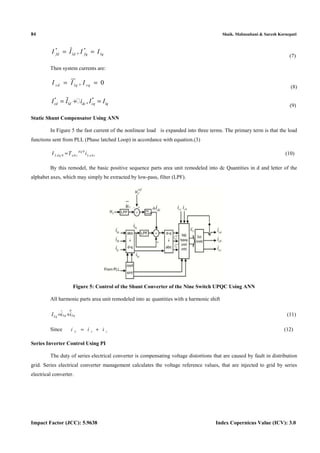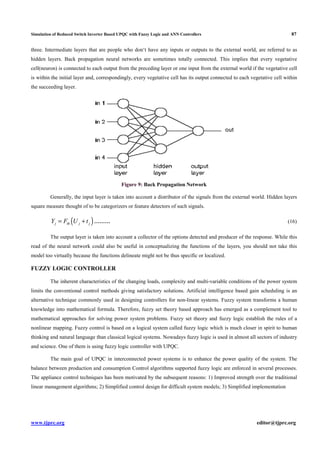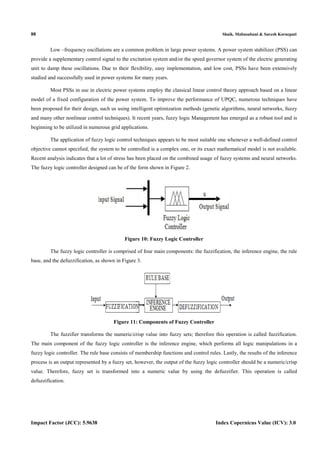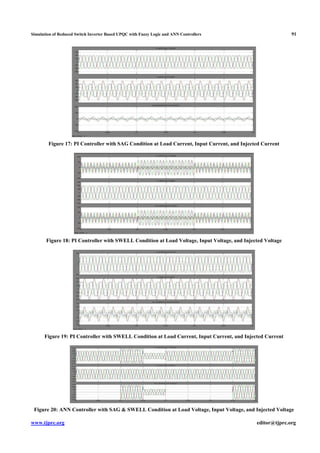The document discusses a novel approach to reduce harmonic distortion in unified power quality conditioners (UPQC) using artificial neural networks (ANN) and fuzzy logic controllers (FLC), aiming to enhance power quality with improved static and dynamic performance compared to traditional PI controllers. It highlights the advantages of a nine-switch UPQC converter over the traditional twelve-switch design, offering better performance while addressing issues like voltage flicker, reactive power, and harmonics. A comprehensive simulation study demonstrates the efficacy of the proposed control methods, indicating significant improvements in power quality and efficiency.
![www.tjprc.org editor@tjprc.org
SIMULATION OF REDUCED SWITCH INVERTER BASED UPQC WITH
FUZZY LOGIC AND ANN CONTROLLERS
SHAIK. MABUSUBANI1
& SURESH KORNEPATI2
1
PG Student, Department of EEE, Sri Mittapalli College of Engineering, Guntur, Andhra Pradesh, India
2
Associate Professor, Head, Department of EEE, Sri Mittapalli College of Engineering, Guntur, Andhra Pradesh, India
ABSTRACT
This paper presents a new methodology to reduce harmonic distortion in UPQC using artificial neural network
and fuzzy logic controller. So this paper main aim is improve power quality by using UPQC with ANN and FLC. The most
purpose of the proposed (ANN & FLC) is capable of providing good static and dynamic performances compared to PI
controller. The UPQC is to control on voltage flicker/unbalance, reactive power and harmonics. In different words, the
UPQC has the potential of up power quality at the purpose of installation on power industrial power systems.
The appliance of computing is growing quick within the space of power electronics and drives. From olden days to now
days we are using twelve switches used in back to back configuration. But now we are using nine switches instead of 12
switches. In 9 switch UPQC converter given the most useful benefits compared to 12 switches power converter. The nine
switches UPQC converter gets the best results by using of three methods. They are one is PI controller technique, ANN
controller technique and FLC controller technique. By contrast PI, FLC and ANN, ANN is better than (FLC & PI) for
power quality enhancement and voltage sag and voltage swell mitigations. The factitious neural network (ANN) is taken
into account as a replacement tool to style management electronic equipment for power-quality (PQ) devices. A whole
simulation study is administrated to analysis the performance of the ANN controller and compares its performance with the
quality FLC & PI controller’s results. The nine-switch convertor has already been proved to possess sure benefits,
additionally to its part saving topological feature. Despite these benefits, the nine-switch convertor has thus far found
restricted applications because of its several perceived performance tradeoffs like requiring associate degree outsized
dc-link capacitance, restricted amplitude sharing, and unnatural part shift between its 2 sets of output terminals. Rather
than acceptive these tradeoffs as limitations, a nine-switch power conditioner is projected here that nearly “converts” most
of those topological short comings into fascinating performance benefits. Aiming more to cut back its switch losses,
Harmonics, Voltage Sag & Swell associate degree acceptable discontinuous modulation theme is projected and studied
here thoroughly to doubly make sure that top reduction of commutations is achieved. With associate degree suitably
designed management theme with PI and ANN with Fuzzy logic controller then incorporated, the nine-switch convertor is
shown to favorably raise the general power quality in Simulation, thus justifying its role as an influence conditioner at a
reduced value.
KEYWORDS: ANN, Active Power Filters, PI Controller, Nine Switch Converter, Power Quality, UPQC
INTRODUCTION
The prime objective of power utility companies is to provide their consumers an uninterrupted sinusoidal voltage
of constant amplitude [1]-[5]. In addition to this, adherence to different power quality standards laid down by different
International Journal of Electrical and
Electronics Engineering Research (IJEEER)
ISSN(P): 2250-155X; ISSN(E): 2278-943X
Vol. 4, Issue 6, Dec 2014, 77-94
© TJPRC Pvt. Ltd.](https://image.slidesharecdn.com/subani-ijeeer-150416084853-conversion-gate01/85/SIMULATION-OF-REDUCED-SWITCH-INVERTER-BASED-UPQC-WITH-FUZZY-LOGIC-AND-ANN-CONTROLLERS-1-320.jpg)
![78 Shaik. Mabusubani & Suresh Kornepati
Impact Factor (JCC): 5.9638 Index Copernicus Value (ICV): 3.0
agencies has become a figure of merit for the power utilities [6]. Unfortunately, this is becoming increasingly difficult to
do so, because
The size and number of non-linear and poor power Factor loads such as adjustable speed drives, computer power
supplies, furnaces, power converters and traction drives are finding its applications at domestic and industrial levels.
These nonlinear loads draw non-linear current and degrade electric power quality. The quality degradation leads to low
power-factor, low efficiency, overheating of transformers and so on [2]. The power electronic devices as a result of their
inherent non-linearity draw harmonic and reactive power from the availability. In 3 phase systems; the reactive power
burden, injected harmonics, excessive neutral currents and unbalance cause low system potency and poor power factor.
Additionally to the present, the ability system is subjected to numerous transients like voltage sags, swells, glints etc.
These transients would have an effect on the voltage at distribution levels. Excessive reactive power of loads would
increment the generating capability of generating stations and increment the transmission losses in lines. Thus provide of
reactive power at the load end becomes essential.
Power Quality (PQ) chiefly deals with problems like maintaining a set voltage at the purpose of Common
Coupling (PCC) for varied distribution voltage levels regardless of voltage fluctuations, maintaining close to unity power
issue power drawn from the supply, obstruction of current and voltage unbalance from passing upwards from varied
distribution levels, reduction of current and voltage harmonics within the system and suppression of excessive provide
neutral current.
Nowadays equipments exploitation power semiconductor devices, usually called active power filters (APF’s),
Active Power Line Conditioners (APLC’s) etc. are used for the power quality problems owing to their dynamic and
adjustable solutions [10]. This paper is intended to provide a comprehensive review on the topic of UPQC. Over 10
publications [1]-[11] are critically reviewed to get proper idea about different intelligent controller used with UPQC.
Beside this, this paper also discusses the most significant concepts that are utilized to control the UPQC.
Since its initial introduction, static power convertor development has full-grown quickly with several convertor
topologies currently pronto found within the open literature. Incidental this development is that the equally speedy
identification of application areas, wherever power converters will contribute absolutely toward raising the general system
quality [1], [2]. In most cases, the known applications would need the ability converters to be connected nonparallel [3] or
shunt [4], looking on the operational situations into consideration. Additionally, they have to be programmed with voltage,
current, and power regulation schemes in order that they will swimmingly make amends for harmonics, reactive power
flow, unbalance, and voltage variations. For even additional tight regulation of provide quality, each a shunt and a series
convertor square measure more with one amongst them tasked to perform voltage regulation, whereas the opposite
performs current regulation. nearly always, these 2 converters square measure connected in an exceedingly back to-back
configuration [5], victimization twelve switches in total and sharing a typical dc-link capacitance, as mirrored by the
configuration drawn in Figure 1(a). Wherever obtainable, a small supply may be inserted to the common dc link, if the
intention is to supply for distributed generation in an exceedingly small grid [6], while not considerably impacting on the
long proved correct functioning of the succeeding configuration.
Presenting a much better reduced semiconductor different for top quality series–shunt compensation, this paper
proposes one stage integrated nine-switch power conditioner, whose circuit association is shown in Figure 1(b). As its
name roughly inferred, the planned conditioner uses a nine-switch convertor with 2 sets of output terminals, rather than the](https://image.slidesharecdn.com/subani-ijeeer-150416084853-conversion-gate01/85/SIMULATION-OF-REDUCED-SWITCH-INVERTER-BASED-UPQC-WITH-FUZZY-LOGIC-AND-ANN-CONTROLLERS-2-320.jpg)
![Simulation of Reduced Switch Inverter Based UPQC with Fuzzy Logic and ANN Controllers 79
www.tjprc.org editor@tjprc.org
same old twelve switch back-to back convertor. The nine-switch convertor was earlier planned in [7] and [8] at regarding a
similar time, and was counseled for twin motor drives [9], rectifier–inverter systems, and uninterruptible power provides
[10]. Despite functioning as supposed, these applications are burdened by the restricted part shift and strict amplitude
sharing enforced between the 2 terminal sets of the nine-switch convertor.
During voltage sags, the second set of management schemes conjointly has the flexibility to endlessly keep the
load voltages inside tolerable vary. This sag mitigation ability, along with different abstract findings mentioned during this
paper however not within the open literature, has already been verified in experiment with favorable results discovered.
Figure 1: (a) Back-To-Back and (b) Nine-Switch Power Conditioners
POWER QUALITY
Power Quality (PQ) connected problems are a unit of most concern today. The widespread use of equipment, like
info technology instrumentality, power physical science like energy-efficient lighting, adjustable speed drives (ASD), PLC,
diode to a whole modification of electrical hundreds nature. These hundreds area unit at the same time the key causers and
also the major victims of power quality issues [8]. Because of their non-linearity, of these hundreds cause disturbances
within the voltage undulation. Alongside technology advance, the organization of the worldwide economy has evolved
towards globalization and also the profit margins of the many activities tend to decrease [11]. The magnified sensitivity of
the overwhelming majority of processes (services, residential and even industrial) to PQ issues turns the provision of
electrical power with quality an important issue for fight in each activity sector. The foremost crucial area units are the
continual method trade and also the info technology services. Once a disturbance happens, immense money losses could
happen, with the ensuing loss of productivity and fight. Though several efforts are taken by utilities, some shoppers need
tier of PQ beyond the extent provided by fashionable electrical networks. This means that some measures should be taken
so as to attain higher levels of Power Quality.](https://image.slidesharecdn.com/subani-ijeeer-150416084853-conversion-gate01/85/SIMULATION-OF-REDUCED-SWITCH-INVERTER-BASED-UPQC-WITH-FUZZY-LOGIC-AND-ANN-CONTROLLERS-3-320.jpg)
![80 Shaik. Mabusubani & Suresh Kornepati
Impact Factor (JCC): 5.9638 Index Copernicus Value (ICV): 3.0
UNIFIED POWER QUALITY CONDITIONER
The Unified Power Quality Conditioner may be a custom power device that is used within the distribution system
to mitigate the disturbances that have an effect on the performance of sensitive and/or essential load. It is a kind of hybrid
APF and is that the solely versatile device which might mitigate many power quality issues connected with voltage and
current at the same time thus is multi functioning devices that compensate numerous voltage disturbances of the ability
offer, to correct voltage fluctuations and to stop harmonic load current from getting into the ability system. The system
configuration of a single-phase UPQC is shown in Figure 2. Unified Power Quality Conditioner (UPQC) consists of 2
IGBT primarily based Voltage supply converters (VSC), one shunt and one series cascaded by a typical DC bus. The shunt
convertor is connected in parallel to the load. It provides power unit support to the load and provides harmonic currents.
Whenever {the offer the availability the provision} voltage undergoes sag then series convertor injects appropriate voltage
with supply [2]. Therefore UPQC improves the ability quality by preventing load current harmonics and by correcting the
input power issue. the most elements of a UPQC square measure series and shunt power converters, DC capacitors,
low-pass and high-pass passive filters, and series and shunt transformers the most purpose of a UPQC is to catch up on
offer voltage power quality problems, such as, sags, swells, unbalance, flicker, harmonics, and for load current power
quality issues, such as, harmonics, unbalance, reactive current, and neutral current. The key elements of this technique
square measure as follows.
• 2 inverters —one connected across the load that acts as a shunt APF and different connected nonparallel with the
road as that of series APF.
• Shunt coupling inductance Lsh is employed to interface the shunt electrical converter to the network. It conjointly
helps in smoothing this wave. Generally associate isolation electrical device is employed to electrically isolate the
electrical converter from the network.
• a typical dc link that may be fashioned by employing a condenser or associate inductance. In Figure 2, the dc link
is accomplished employing a condenser that interconnects the 2 inverters and conjointly maintains a continuing
independent dc bus voltage across it.
• Associate LC filter that is a passive low-pass filter (LPF) and helps to eliminate high-frequency switch ripples on
generated electrical converter output voltage.
• Series injection electrical device that is accustomed connect the series electrical converter within the network.
An acceptable flip magnitude relation is commonly thought-about to scale back the voltage and current rating of
series electrical converter.
In principle, UPQC is associate integration of shunt and series APFs with a typical independent dc bus. The shunt
electrical converter in UPQC is managementled in current management mode such it delivers a current that is adequate to
the set price of the reference current as ruled by the UPQC control algorithmic program. To boot, the shunt electrical
converter plays a vital role in achieving needed performance from a UPQC system by maintaining the dc bus voltage at a
group reference price. So as to cancel the harmonics generated by a nonlinear load, the shunt electrical converter ought to
inject a current. Similarly, the series electrical converter of UPQC is managementled in voltage control mode such it
generates a voltage and injects nonparallel with line to realize a curved, free from distortion and at the required magnitude
voltage at the load terminal. Within the case of a voltage sag condition, actual supply voltage can represent the distinction](https://image.slidesharecdn.com/subani-ijeeer-150416084853-conversion-gate01/85/SIMULATION-OF-REDUCED-SWITCH-INVERTER-BASED-UPQC-WITH-FUZZY-LOGIC-AND-ANN-CONTROLLERS-4-320.jpg)













